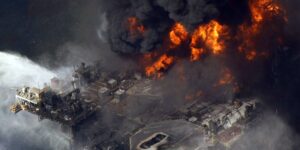 Hurricanes Harvey, Irma and Maria represented the first real test of the staying power of the alternative capital sector, which has responded with a show of strength by continuing to fund reinsurance capacity, according to a report published by Aon Benfield.
Hurricanes Harvey, Irma and Maria represented the first real test of the staying power of the alternative capital sector, which has responded with a show of strength by continuing to fund reinsurance capacity, according to a report published by Aon Benfield.
Alternative capital – supplied by investors from the capital markets – now plays “a much more significant role in the global retrocession and U.S. property catastrophe reinsurance market and therefore incurred sizable losses as a result of recent events,” said the report titled “Reinsurance Market Outlook – Reinsurance Proves Its Worth, January 2018.”
Nevertheless, investors have committed new funds to replace lost or trapped collateral after last year’s hurricanes, which had insured losses of US$80 billion, said Aon Benfield in the report. (See below for an explanation of “trapped collateral.”)
The catastrophe bond market continues to exhibit high levels of activity, which means the sector has “proved its worth and come of age as a committed source of reinsurance capacity,” the report added.
The alternative capital sector supplied almost US$90 billion of capacity in 2017, a significant increase from only US$10 billion provided in 2005, Aon Benfield’s report indicated.
Assets under management dipped to US$82 billion at Sept. 30, 2017 – after the third quarter’s hurricane losses, said the report, noting, however, this total represented a small increase from the beginning of 2017.
Reinsurance Supply
The report said global reinsurer capital – which includes traditional and alternative capital – reached $600 billion at Sept. 30, 2017, an increase of 1 percent over the figure reported for the end of 2016.
“Over the nine months to Sept. 30, 2017, traditional capital rose by US$4 billion to US$518 billion, while alternative capital rose by US$1 billion to US$82 billion,” the report confirmed.
Aon Benfield described the global figure for reinsurer capital as a broad measure of the capital available to reinsurance buyers seeking to cede their risks – a demand that increased modestly during 2017.
Some of the reasons cited by the report for the increased reinsurance demand were the growing prevalence of risk-based capital regimes, changes to A.M. Best’s rating methodology, and, of course, heightened risk awareness after recent major catastrophe losses.
Manageable Costs of Global Natural Disasters
The report then went on to discuss how the reinsurance industry is well positioned to handle last year’s high catastrophe losses, which generated insured losses to the private sector and government-sponsored programs of US$128 billion in 2017. (Munich Re’s estimated insured price tag for last year’s natural disasters is US$135 billion.)
Aon Benfield said its estimate of $128 billion is 129 percent higher than the $56 billion sustained in 2016 and 151 percent higher than the 2000-2016 average of $51 billion.
“It is estimated that less than a third of these losses fell to the private reinsurance market, representing a very manageable burden relative to a capital base of around US$600 billion,” the report explained.
The report cited the main drivers of last year’s losses as:
- Tropical cyclones. These storms generated $83 billion of losses, second only to the $110 billion in 2005. Included in 2017’s tropical cyclone tally are the insured losses from Hurricanes Harvey, Irma and Maria – currently estimated at $80 billion.
- Severe weather events (convective storms). These events generated $23 billion of insured losses in 2017, second only to 2011 at $32 billion. “Around 90 percent of these losses occurred in the U.S., the main driver being hailstorms.”
- Wildfires. An October outbreak of wildfires in Northern California’s Napa Valley region caused more than $10 billion in insured losses, with a “significant” impact on some reinsurance programs. Other major wildfires occurred in Portugal and South Africa.
Protection Gap
The report emphasized that global natural catastrophes continue to highlight the insurance protection gap that exists even in developed markets. The protection gap is the difference between uninsured losses, or economic losses, and those losses that are insured.
Aon Benfield calculates that last year’s natural catastrophes caused economic losses of around US$320 globally, with insured losses of $128 billion. This means that the proportion of total losses covered by insurance was approximately 40 percent in 2017.
“The insurance recovery ratio in the U.S. is estimated at 47 percent,” which is below the 17-year average of 54 percent. The report attributed this drop to the relatively high proportion of uninsured losses caused by flooding (particularly during Hurricane Harvey).
Trapped Collateral
An Aon Benfield spokesman explained “lost” and “trapped collateral,” terms used in the alternative capital sector.
While “lost collateral” is simply capital that has suffered loss due to an event, “trapped collateral” can occur when a cedent does not know the full extent of its losses and will thus wait to allow those losses to fully develop until the end of the contract period, which is likely to be year-end.
“Some of this capital may not be affected by the loss, but for some time will effectively be ‘trapped’ until it is paid back to the investor,” said the spokesman.
*This story appeared previously in our sister publication Insurance Journal.





















 Is State Farm General Too Big to Fail? Calif. Rate Hearing Concludes
Is State Farm General Too Big to Fail? Calif. Rate Hearing Concludes  Severe Midwest Storms Result in Baseball Size Hail
Severe Midwest Storms Result in Baseball Size Hail  Wildfire Losses Increasing But Still Small Compared to Hurricanes: KCC
Wildfire Losses Increasing But Still Small Compared to Hurricanes: KCC  Lemonade: 700K Customers on the Car Waitlist
Lemonade: 700K Customers on the Car Waitlist 











